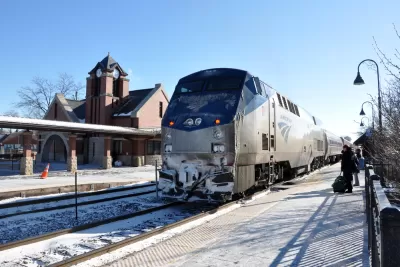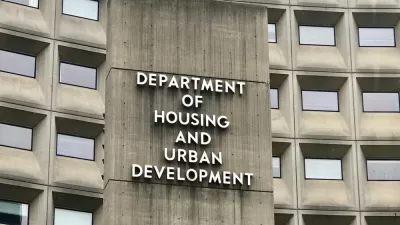"Affirmatively Furthering Fair Housing"—as a new rule by the U.S. Department of Housing and Urban Development proposes to do—can vary widely, even in the same city.

In July 2015, the Department of Housing and Urban Development (HUD) released its final rules for Affirmatively Furthering Fair Housing (AFFH), by which HUD is requiring communities to take action to break down barriers of segregation and equalize opportunity and prosperity for all. That opportunity, particularly connections to jobs and economic mobility, can vary dramatically from one neighborhood to another. When affordable housing is included in transit oriented development, households without cars can still reach many jobs without a car. When affordable housing is constructed in isolated points of least resistance, residents won't have that same access to jobs. Communities must consider the access offered by transit oriented development as a key aspect of fair housing when following these rules.
Two properties in Glenview, IL—both annexed in the 1990s, one existing, sunset village, and one to be redeveloped, The Glen, into a commercial and residential town center near transit—illustrate this point. In the mid-1990s Glenview became the master developer for the former Glenview Naval Air Station. The redevelopment of this area became known as the Glen. The Glen is classic transit oriented development (TOD): it includes housing, shopping, and units for low-income seniors, all within walking distance of Metra’s Milwaukee District North line and bus stops throughout the area. In the Glen, residents can meet some of their daily needs locally and take transit to get to jobs downtown and in nearby suburban job centers.
Contrast that with Sunset Village, a manufactured housing community that has been in existence since the 1950s and was originally developed on unincorporated land. Until Glenview annexed the property, Sunset Village was loosely regulated. Over time, the infrastructure of the community began to crumble. Residents complained about frequent water shutoffs, poor quality water, and no fire hydrants. These days, Sunset Village has been incorporated, and Glenview regularly monitors it, but a legacy of disconnection endures. Mobile home units in Sunset Village are very close together, and there is very limited access to the economic and cultural benefits of the surrounding neighborhoods, with only one exit onto the heavily trafficked Waukegan Road. The community is connected to a walking path that leads to The Glen, but it is not a direct walk and can be too far for the elderly and disabled. The residents of Sunset Village often carpool due to the lack of transit, especially on the weekends.
Carol is an older adult resident living in Sunset Village who works in Chicago and takes Metra to work. Years ago she could use the walking path to get to the train, but now she is unable to walk that far. Except for those lucky days when she can carpool, Carol takes Pace Bus 422 to the Glenview Metra Station, which adds about 20-30 minutes to her commute. Because the 422 bus only runs during peak hours and not on weekends, Carol is effectively stranded at Sunset Village on Saturdays and Sundays. "If I get a ride it’s about 20 minutes to get to work and if I take the bus it is about 45 minutes to an hour," Carol says. Just north of Sunset Village a commercial corridor exists, but it is too far for her to walk; she has good neighbors who are willing to give her rides, but can’t depend on them all the time.
The truth is that one of these locations, the Glen, offers households, like Carol's, a better shot at economic mobility. From the Glen, a household can easily walk to the Metra Milwaukee District line and reach 209,344 jobs within a 30 minute transit ride. Contrast that with Sunset Village, located along a busy four lane road and disconnected from the Glen by a creek and an indirect, windy walking path. Although Sunset Village is a little more than a half mile further from the Metra Milwaukee District as the crow flies, residents there can only access 92,500 jobs. That's less than half as many. When the urban environment cuts low-income residents in places like Sunset Village off from transit and jobs, it disconnects them from participation in the broader economy.
The new HUD rules will require governments receiving public programs like Community Development Block Grants (CDBG) and HOME Investments Partnership Program to demonstrate how they are proactively breaking down segregation. As municipalities do so, it will be critically important that they target housing creation in connected communities like the Glen, and work to better integrate properties like Sunset Village with transit and the broader community. Access to transit is one of the tools a community can use to affirmatively further fair housing. Often cited as a barrier to fair housing, access to transit can and does create affordable housing by cutting down on the number of cars needed and the frequency or trips made in a car. While Glenview is not an entitlement community, Cook County is, and will need to affirmatively further fair housing in a way that emphasizes transit and jobs in places like the Glen.
So what can communities do?The first step comes through proactively planning mixed-use and mixed-income communities built around transit. Last November, the Center for Neighborhood Technology (CNT) and Open Communities produced Quality of Life, (e)Quality of Place, a toolbox of policies that suburbs can pursue to advance mixed-income TOD. Suburbs can include affordable and mixed-income component to a TOD plan; municipalities that lack the capacity to do so themselves can turn to the RTA’s Community Planning program for assistance. Additionally, zoning incentives that support inclusionary development also support TOD. These include inclusionary up-zoning bonuses like increased density bonuses and reduced parking requirements that support vibrant urban communities and pass on the value in new affordable units.
The second step comes through proactively targeting public investments, including Community Development Block Grants, Low Income Housing Tax Credits, and HOME Investments Partnership Program, and Housing Choice Vouchers to support development in those communities with the best access to housing and jobs. Additionally, transportation investments, like a direct walking path to the train station, can Affirmatively Further Fair Housing by better connecting low-income neighborhoods with transit and the job accessibility that transit provides. Tools like CNT's AllTransit and Housing + Transportation Affordability Index can help communities pinpoint the exact location for these investments within their own boundaries.
To truly break down segregation, all levels of government should ensure that we don't concentrate affordable units in locations like Sunset Village, where poverty is pushed out of sight. With high quality, mixed-income TOD, communities can meet HUD rules and build their tax bases, spur economic development, and reconnect low-income people with opportunity at the same time.
Kyle Smith is manager of Transit-Oriented Development at the Center for Neighborhood Technology (CNT) in Chicago.
Brendan Saunders is a director of Advocacy & Community Organizing at Open Communities in Chicago.

Planetizen Federal Action Tracker
A weekly monitor of how Trump’s orders and actions are impacting planners and planning in America.

Chicago’s Ghost Rails
Just beneath the surface of the modern city lie the remnants of its expansive early 20th-century streetcar system.

San Antonio and Austin are Fusing Into one Massive Megaregion
The region spanning the two central Texas cities is growing fast, posing challenges for local infrastructure and water supplies.

Since Zion's Shuttles Went Electric “The Smog is Gone”
Visitors to Zion National Park can enjoy the canyon via the nation’s first fully electric park shuttle system.

Trump Distributing DOT Safety Funds at 1/10 Rate of Biden
Funds for Safe Streets and other transportation safety and equity programs are being held up by administrative reviews and conflicts with the Trump administration’s priorities.

German Cities Subsidize Taxis for Women Amid Wave of Violence
Free or low-cost taxi rides can help women navigate cities more safely, but critics say the programs don't address the root causes of violence against women.
Urban Design for Planners 1: Software Tools
This six-course series explores essential urban design concepts using open source software and equips planners with the tools they need to participate fully in the urban design process.
Planning for Universal Design
Learn the tools for implementing Universal Design in planning regulations.
planning NEXT
Appalachian Highlands Housing Partners
Mpact (founded as Rail~Volution)
City of Camden Redevelopment Agency
City of Astoria
City of Portland
City of Laramie





























